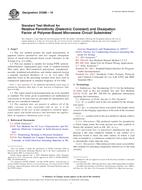Potrebujeme váš súhlas na využitie jednotlivých dát, aby sa vám okrem iného mohli ukazovať informácie týkajúce sa vašich záujmov. Súhlas udelíte kliknutím na tlačidlo „OK“.
ASTM D3380-10
Standard Test Method for Relative Permittivity (Dielectric Constant) and Dissipation Factor of Polymer-Based Microwave Circuit Substrates
Automaticky preložený názov:
Štandardná skúšobná metóda pre relatívnu permitivita ( Dielektrická konštanta ) a stratového činiteľa na báze polymérov Mikrovlnné Circuit substráty
NORMA vydaná dňa 1.1.2010
Informácie o norme:
Označenie normy: ASTM D3380-10
Poznámka: NEPLATNÁ
Dátum vydania normy: 1.1.2010
Kód tovaru: NS-23476
Počet strán: 13
Približná hmotnosť: 39 g (0.09 libier)
Krajina: Americká technická norma
Kategória: Technické normy ASTM
Anotácia textu normy ASTM D3380-10 :
Keywords:
dielectric constant, dissipation, loss tangent, permittivity, polymer-based substrates, relative permittivity, resonator, stripline, x-band, ICS Number Code 31.180 (Printed circuits and boards)
Doplňujúce informácie
| Significance and Use | ||||||||
|
Permittivity and dissipation factor are fundamental design parameters for design of microwave circuitry. Permittivity plays a principal role in determining the wavelength and the impedance of transmission lines. Dissipation factor (along with copper losses) influence attenuation and power losses. This test method is suitable for polymeric materials having permittivity in the order of two to eleven. Such materials are popular in applications of stripline and microstrip configurations used in the 1 to 18 GHz range. This test method is suitable for design, development, acceptance specifications, and manufacturing quality control. Note 2—See Appendix X1 for additional information regarding significance of this test method and the application of the results. |
||||||||
| 1. Scope | ||||||||
|
1.1 This test method permits the rapid measurement of apparent relative permittivity and loss tangent (dissipation factor) of metal-clad polymer-based circuit substrates in the X-band (8 to 12.4 GHz). 1.2 This test method is suitable for testing PTFE (polytetrafluorethylene) impregnated glass cloth or random-oriented fiber mats, glass fiber-reinforced polystyrene, polyphenyleneoxide, irradiated polyethylene, and similar materials having a nominal specimen thickness of 1/16 in. (1.6 mm). The materials listed in the preceding sentence have been used in commercial applications at nominal frequency of 9.6 GHz. Note 1—See Appendix X1 for additional information about range of permittivity, thickness other than 1.6 mm, and tests at frequencies other than 9.6 GHz. 1.3 The values stated in inch-pound units are to be regarded as standard. The values given in parentheses are mathematical conversions to SI units that are provided for information only and are not considered standard. 1.4 This standard does not purport to address all of the safety concerns, if any, associated with its use. It is the responsibility of the user of this standard to establish appropriate safety and health practices and determine the applicability of regulatory limitations prior to use. |
||||||||
| 2. Referenced Documents | ||||||||
|
Odporúčame:
Aktualizácia technických noriem
Chcete mať istotu, že používate len platné technické normy?
Ponúkame Vám riešenie, ktoré Vám zaistí mesačný prehľad o aktuálnosti noriem, ktoré používate.
Chcete vedieť viac informácií ? Pozrite sa na túto stránku.




 Cookies
Cookies
